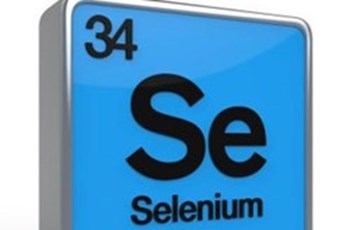
A balance of nutrients is required by our bodies to maintain good health, and selenium (Se) is an important one that often gets overlooked.
This essential element is a required component of the selenoproteins, which include those that are needed to convert thyroid hormone from the inactive to the active form, and several important anti-oxidants.
While optimal selenium levels are imperative for proper thyroid function, abnormally high selenium intake can be toxic – causing gastrointestinal disturbances, changes in nails and hair, weakness, convulsions and decreased cognitive function. So it’s important to understand the ways in which we take in selenium, both in the diet and as supplements.
When choosing a selenium supplement, the various forms of selenium available can be confusing. The most common forms found in the diet and as supplements are summarized below.
Organic Forms of Selenium
- Selenomethionine (as L-selenomethionine; sometimes called selenium monomethionine) is formed in plants when selenium substitutes for sulfur during synthesis of the amino acid methionine, and becomes incorporated into proteins in place of methionine. It is the predominant form of selenium in Brazil nuts, cereals, legumes, and fish.
- Selenocysteine, a selenium-containing amino acid. In humans, it is one of the 22 proteinogenic amino acids and is incorporated into 25 known selenoproteins during protein synthesis. These selenoproteins are vital to human health, and include the antioxidants glutathione peroxidase and selenoprotein P, the thioredoxin reductases, and the deiodinases involved in thyroid hormone activation.
- Methylselenocysteine (also known as Se-methyl-selenocysteine) and its derivative gamma-glutamyl Se-methylselenocysteine are metabolic products of selenocysteine that are the predominant form of selenium in plants of the allium (onions, garlic) and brassica (cruciferous vegetables, e.g., broccoli, cabbage) families.
Inorganic Selenium
- Selenite, used in supplements and the most common form of selenium used in pet foods.
- Selenate is the predominant form of selenium in shellfish and vegetables (other than the allium and brassica families) grown in seleniferous soil.
Selenium-Enriched Yeast
The supplement known as selenium-enriched yeast is yeast grown in a medium containing inorganic selenium, usually sodium selenite. The selenium becomes organically bound to the yeast, mostly being incorporated into the yeast proteins. The supplement therefore consists predominantly of selenomethionine (between 60 and 80%), but also has small amounts of selenocysteine, methylselenocysteine and gamma-glutamyl Se-methylselenocysteine. Reputable manufacturers ensure that the majority (at least 90%) of the selenite is organically bound to the yeast; otherwise, the product may simply contain a mixture of inorganic selenite and yeast.
What Form is Best?
Selenium in any form, whether from food or supplements, organic or inorganic, is utilized by the body for selenoprotein synthesis after first being metabolized to hydrogen selenide, the cellular storage form of selenium. Surplus selenium is converted to methylated metabolites and excreted via the urine and in the breath. Excessive buildup of hydrogen selenide can lead to its oxidation, resulting in the production of reactive oxygen species (ROS) leading to oxidative toxic effects in the body. Inorganic selenite also has pro-oxidant properties that can result in toxic effects when present in excess.
All forms of selenium are well absorbed, but absorption of selenomethionine is the best. It uses the same active transport mechanism as for methionine, one of the 9 essential amino acids that can only be obtained from the diet, and this increases the efficiency of absorption of selenomethionine over inorganic forms of selenium. Some supplements include vitamin E and it has been claimed that this facilitates selenium absorption, but there is no evidence that this is the case; vitamin E is included in some supplements because its antioxidant effects are synergistic with selenium.
Selenium Species with Anti-Cancer Effects
The anticancer effects of selenium differ depending on which form is used. An observed association between low selenium status and an increased risk of prostate cancer led to studies of selenium supplementation in an effort to mitigate risk. Supplementation with selenium-enriched yeast in the Nutritional Prevention of Cancer (NPC) trial reduced the incidence of prostate cancer by 52-65%, but the Selenium and Vitamin E Cancer Prevention Trial (SELECT) used selenomethionine supplements with or without vitamin E and was discontinued after 5.5 years when no benefit was seen in terms of prostate cancer risk reduction. Although selenium-enriched yeast predominantly consists of selenomethionine, it also contains small amounts of methylselenocysteine and gamma-glutamyl Se-methylselenocysteine, which are believed to be responsible for the observed anticancer effects in the NPC trial. Also, the pro-oxidant properties of selenium species such as selenite contribute to ROS-mediated apoptosis. Cancer cells usually exist under mildly oxidative conditions and are more susceptible to oxidative stress than normal cells, and so research is ongoing in the development of anticancer drugs based on selenite that utilize this mechanism.
How Much Selenium Do We Need?
When selenium levels are optimized there has been an observed decrease in the risks of prostate, lung, colorectal, and bladder cancer; however, excessive selenium supplementation in selenium-replete populations has been found to increase risk of type 2 diabetes. Additional selenium supplements, whether organic or inorganic, may therefore be detrimental to people with already adequate or high dietary selenium intake. The current recommended dietary allowance (RDA) in adults is 55 micrograms/day. Urine testing while maintaining the patient’s usual diet and supplementation can help determine whether selenium status is adequate, too low or too high.
For detailed recommended intakes and a list of selenium-containing foods, see the NIH Office of Dietary Supplements Dietary Supplement Fact Sheet: Selenium (for Health Professionals).
To learn more about simple dried urine testing for selenium, read ZRT's informational guide on elements and thyroid function.
Related Content
- Blog: Environmental Elements & Your Thyroid Health
- Blog: Got Iodine? How to Get Enough Iodine through Your Diet.
- Web: Learn More about Simple Iodine & Selenium Testing
References
Rayman MP. Food-chain selenium and human health: emphasis on intake. Br J Nutr. 2008;100(2):254-68.
Rayman MP. Selenium and human health. Lancet. 2012;379(9822):1256-68.
